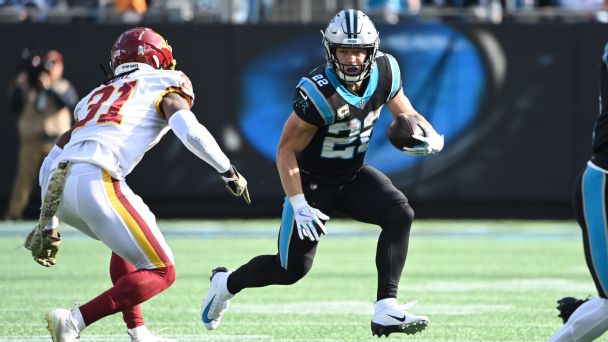Is Frank Gore a first-ballot Hall of Fame player?

Keyshawn Johnson and Rob Ninkovich discuss how special Frank Gore was and the respect they have for his career. (1:04)
Running back Frank Gore signed a one-day contract with the San Francisco 49ers, ending his NFL career where it started as a third-round pick (65th overall) in 2005.
Gore last played Dec. 27, 2020, when he gained 48 yards on 14 carries in the New York Jets‘ 23-16 victory over the Cleveland Browns. Those 48 rushing yards gave Gore exactly 16,000 rushing yards during a 16-year playing career with five different teams.
That puts Gore at No. 3 all-time in rushing. The quick-hit portions of his potential Hall of Fame résumé include his selection as one of four running backs on the All-Decade team of the 2010s and five Pro Bowls.
Whenever a player of Gore’s production calls it a career, the phrase “next stop Canton” will get tossed around. And as one of the voters for the Pro Football Hall of Fame, it’s my belief Gore will be enshrined.
The real question is: Will Gore be a first-ballot Hall of Famer? The short answer is it depends on who else is among the 15 finalists. If wide receiver Larry Fitzgerald doesn’t attempt a comeback, he and Gore will be eligible for the first time in the Hall of Fame’s Class of 2026. Gore’s clock started from his last season played, not his retirement announcement.
So start with the big-ticket items. The top 16 all-time rushers in NFL history who are Hall of Fame eligible are already in the Hall of Fame. Then Nos. 19 (John Riggins), 21 (O.J. Simpson) and 34 (Joe Perry) are also enshrined.
The only running backs among those top 16 who are not enshrined are Gore and Adrian Peterson, who is still a free agent. For his part, Peterson was one four players on offense who was a unanimous selection on the 2010s All-Decade team (Tom Brady, Joe Thomas and Marshal Yanda were the others).
If Peterson doesn’t play any more games, he would be eligible for the Hall of Fame beginning in 2027.
If Gore doesn’t make it as a first-time eligible player and he and Peterson appear on the Hall of Fame ballot at the same time, there is always the prospect – and a common one at that – they split votes. This has happened many times through the years at a variety of positions, especially at wide receiver – the Tim Brown, Andre Reed, Terrell Owens gridlock was one of the most recent examples.
All three were eventually enshrined, but Reed was a finalist eight times, Brown was a finalist six times and Owens a finalist three times.
The last time two running backs were enshrined in the same Hall of Fame class was 2017 when LaDainian Tomlinson, in his first year of eligibility, and Terrell Davis (a three-time finalist) were selected. It hadn’t happened since 1994 before that class.
• McCaffrey all in on Faulk’s health advice
• Bradberry finds fit with Eagles
• Giants defense ready to be aggressive
• Inside Jets’ head-turning offseason
• How Parcells prepped Bills rookie Kaiir Elam
Overall, the list of all-time rushing leaders is likely a far better measuring stick for Hall of Fame consideration than, say, the list of all-time passers, which seems to change every month of every season. The league isn’t kind to running backs these days and there is no one threatening to crack the 12,000-yard barrier any time soon.
Tomlinson is the only running back, other than Gore and Peterson, among the league’s top 12 all-time rushers who even played in a game after 2005. And only four among the top 16 all-time rushers played a game since the 2009 season started.
Hall of Fame discussions are always filled with emotion because the math is soul-crushingly simple. Every team in the league has, at minimum, four players who are not enshrined who each of those teams consider a slam-dunk, no-brainer, it’s-a-travesty-he’s-not-in player.
That’s 32 teams multiplied by four — 128 players — with, count ‘em, a maximum of five modern era slots for the Hall class each year. If no new players were even added to the ballot each year that would be 25.6 years to handle even that group.
Much of the angst in the social media world about the Hall, beyond those who have waited, or can’t even make the list of finalists, is the whole first-ballot thing.
Look, the gold jacket is the same gold for John Elway as it was for Floyd Little who waited almost four decades after he played his last game to be enshrined. They don’t use different bronze for the busts of Hall of Famers selected in their first year of eligibility.
A sampling of players enshrined through the decades who were not selected in their first year of eligibility include Willie Davis, Joe Namath, Willie Lanier, Alan Page, John Mackey and Ozzie Newsome.
Gore’s case for the Hall is consistent top-shelf production. He’s somewhat of a medical marvel, suffering two ACL tears in college before becoming one of the league’s most durable players for almost two decades. When the arguments get heated at some point in the process years from now, some will say Gore finished among the league’s top five rushers in only one of his seasons and never had the good fortune of playing with a Super Bowl winner.
But all of that is for another day five years from now. After 241 regular-season games played, nine 1,000-yard seasons, 11 900-yard seasons, today is one for Gore to celebrate. It was a rare career by a rare player who got to say goodbye where it all started.